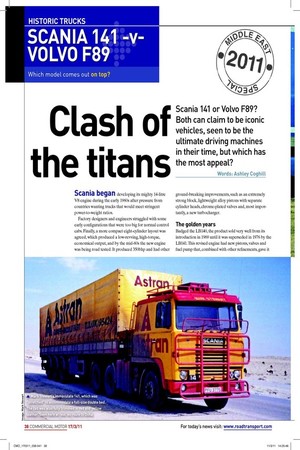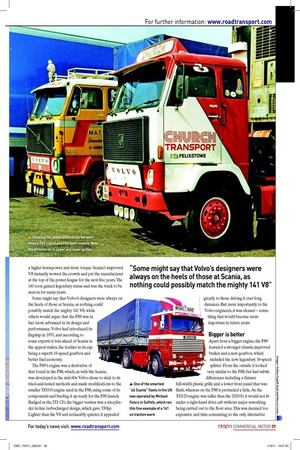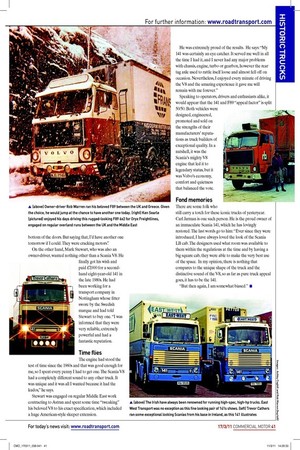Clash of the titans
Page 27

Page 28

Page 29

Page 30

If you've noticed an error in this article please click here to report it so we can fix it.
Scania 141 or Volvo F89? Both can claim to be iconic vehicles, seen to be the ultimate driving machines in their time, but which has the most appeal?
Words: Ashley Coghill
Scania began developing its mighty 14-litre V8 engine during the early 1960s after pressure from countries wanting trucks that would meet stringent power-to-weight ratios.
Factory designers and engineers struggled with some early configurations that were too big for normal control cabs. Finally, a more compact eight-cylinder layout was agreed, which produced a low-revving, high-torque, economical output, and by the mid-60s the new engine was being road tested. It produced 350bhp and had other ground-breaking improvements, such as an extremely strong block, lightweight alloy pistons with separate cylinder heads, chrome-plated valves and, most importantly, a new turbocharger.
The golden years
Badged the LB140, the product sold very well from its introduction in 1969 until it was superseded in 1976 by the LB141. This revised engine had new pistons, valves and fuel pump that, combined with other refinements, gave it a higher horsepower and more torque. Scania’s improved V8 instantly wowed the crowds and put the manufacturer at the top of the power league for the next five years. The 141 soon gained legendary status and was the truck to be seen in for many years.
Some might say that Volvo’s designers were always on the heels of those at Scania, as nothing could possibly match the mighty 141 V8, while others would argue that the F89 was in fact more advanced in its design and performance. Volvo had introduced its flagship in 1970, and according to some experts it was ahead of Scania in the appeal stakes, the feather in its cap being a superb 16-speed gearbox and better fuel economy.
The F89’s engine was a derivative of that found in the F88, which, as with the Scania, was developed in the mid-60s. Volvo chose to stick to its tried-and-tested methods and made modifications to the smaller TD100 engine used in the F88, using some of its components and beefing it up ready for the F89 launch. Badged as the TD 120, the bigger version was a six-cylinder in-line turbocharged design, which gave 330hp. Lighter than the V8 and noticeably quieter, it appealed greatly to those driving it over long distances. But more importantly to the Volvo engineers, it was cleaner – some thing that would become more important in future years.
Bigger is better
Apart from a bigger engine, the F89 featured a stronger chassis, improved brakes and a new gearbox, which included the now legendary 16-speed splitter. From the outside it looked very similar to the F88, but had subtle differences including a thinner full-width plastic grille and a lower front panel that was flush, whereas on the F88 it protruded a little. As the TD120 engine was taller than the TD100, it would not fit under a right-hand drive cab without major reworking being carried out to the floor area. This was deemed too expensive and time consuming, so the only alternative was to tilt the engine drastically to the right and mount it in that manner. It meant the F89 was only available as a left-hand-drive vehicle. Chris Evans has worked for Volvo Trucks since 1975 and has been involved with numerous new projects, but still has vivid memories of the F89. Originally he worked at Ailsa Trucks in Irvine, Scotland, as an “experimental engineer” .
He told CM: “My first impression of the F89 has stayed with me to this day. I took one on a test drive and the power was unbelievable. The way that truck went along the road was quite remarkable. I recall the engine was quite high revving and I got up to 70mph effortlessly on the motorway. But above all, I remember how quiet it was to drive and the quirky little splitter switch mounted on the dash console was a joy. The seats were so comfortable I never got tired of driving the F89. At the time the vehicle was so advanced compared with any of the British trucks”.
Rob Warren is a seasoned owner-driver who ran a couple of F89s during the 1980s. “I chose the F89 over the V8 Scania simply due to costs of parts and the fact that the Volvo engine wasn’t as complicated to work on,” he says.
“I wasn’t bothered about fuel economy as my truck had big fuel tanks and diesel was quite cheap, especially as I always filled up abroad. I paid around £2,800 for a four-year-old F89 which I ran to Greece for a few years. I must admit that it struggled to keep up with the 141s on the hills, but on the flat it would fly along and keep up with them all day long.”
Breaking down
Warren continues: “I did have a couple of turbos give up in my time. I spotted huge plumes of smoke in the mirrors, so much so that I couldn’t see the front of the trailer, and that was the big giveaway to stop quickly. The same problem on the 141 caused the turbo to literally break up and go into the engine, causing all sorts of problems. I think I paid around £50 for an exchange Volvo turbo in those days. The ride in the F89 was very hard, but it handled well across the rough terrain and I can’t recall having any broken springs or other major chassis problems.
“The only real downside to the F89 was rust. It appeared so quickly, especially around cab joints and the bottom of the doors. But saying that, I’d have another one tomorrow if I could. They were cracking motors”.
On the other hand, Mark Stewart, who was also an owner-driver, wanted nothing other than a Scania V8. He finally got his wish and paid £7,000 for a secondhand eight-year-old 141 in the late 1980s. He had been working for a transport company in Nottingham whose fitter swore by the Swedish marque and had told Stewart to buy one. “I was informed that they were very reliable, extremely powerful and had a fantastic reputation.
Time flies
The engine had stood the test of time since the 1960s and that was good enough for me, so I spent every penny I had to get one. The Scania V8 had a completely different sound to any other truck. It was unique and it was all I wanted because it had the kudos,” he says.
Stewart was engaged on regular Middle East work contracting to Astran and spent some time “tweaking” his beloved V8 to his exact specification, which included a huge American-style sleeper extension. He was extremely proud of the results. He says: “My 141 was certainly an eye catcher. It served me well in all the time I had it, and I never had any major problems with chassis, engine, turbo or gearbox, however the rear tag axle used to rattle itself loose and almost fell off on occasion. Nevertheless, I enjoyed every minute of driving the V8 and the amazing experience it gave me will remain with me forever.” Speaking to operators, drivers and enthusiasts alike, it would appear that the 141 and F89 “appeal factor” is split 50/50. Both vehicles were designed, engineered, promoted and sold on the strengths of their manufacturers’ reputations as truck builders of exceptional quality. In a nutshell, it was the Scania’s mighty V8 engine that led it to legendary status, but it was Volvo’s economy, comfort and quietness that balanced the vote.
Fond memories
There are some folk who still carry a torch for these iconic trucks of yesteryear. Carl Jarman is one such person. He is the proud owner of an immaculate Scania 141, which he has lovingly restored. The last words go to him: “Ever since they were introduced, I have always loved the look of the Scania LB cab. The designers used what room was available to them within the regulations at the time and by having a big square cab, they were able to make the very best use of the space. In my opinion, there is nothing that compares to the unique shape of the truck and the distinctive sound of the V8, so as far as pure truck appeal goes, it has to be the 141.
“But then again, I am somewhat biased.” ■


















































